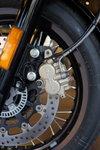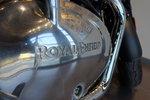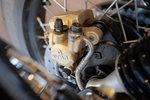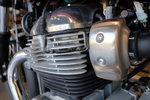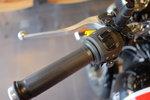Yesterday, Friday the fifteenth, I had the opportunity to ride the new Royal Enfield Interceptor 650. I like the bike.

The unstressed 9.5:1, 648cc twin cylinder engine is a peach. There's plenty of pull to nip into gaps between cars, and enough to keep clear of traffic once ahead. The exhaust note and induction sound like they have been carefully tailored to suit the bike. The gearbox is light and precise, quite unlike the industrial designs used by Honda and Yamaha in similarly priced machines. The fueling was one of the better implementations of a Euro 4 compliant specification with none of the dreaded "throttle-off, engine cut" behaviour that has plagued the Japanese manufacturers. There was a pleasing "pop!" in the exhaust on the over-run. The handling on the Interceptor is light, most likely a result of the upright seated position and the twenty-four degree steering angle. Both with and without a pillion passenger, the front and back brakes worked well and inspired confidence. Braided cables come as standard which is a nice touch. Overall, the Interceptor was one of those bikes that feels easy to ride and which cruises at around 4,000rpm effortlessly.

What of the quality of finish? Analogue clocks match the Seventies style; speed and revs. Who needs to know more? An LCD insert displays mileage and fuel. I would like to have a display of the time. But is it necessary? These days, who doesn't have a wristwatch?
A full size headlamp with an incandescent bulb fulfills the bike's design ethos. Does it put out enough light? How do I know, the test ride was in brilliant sunshine. Does it look good? Oh yes.
The switchgear is functional. How well will the plastic age? Will it fade? These are things that experienced RE owners might wish to comment on. As far as operation is concerned, the switches felt positive and naturally positioned.
There is a preponderance of steel bolts throughout the bike. The fastidious might want to change them for stainless. Aesthetically some of the welds, for example on the swing-arm, aren't pretty. But they are easy to over-look since Royal Enfield have nailed the overall look of the bike so well.
To me, the crankcase looks like it could do with a final polish. As an owner that's exactly what I would do. There is no doubt there is plenty of room for cosmetic customisation. In my opinion, the base bike is worth the effort.
As for colour schemes, the "standard" colours are available first. According to RE Chiang Mai, the black tank won't be in the first batch of bikes to reach Thailand. And chrome may be up to six months away as RE ramp up their production to meet global demand. On the subject of chrome, a small request to RE's management. It would be good to see chrome mudguards to match the chrome tank option.
One criticism of the Interceptor is that the pilot's pegs are splayed a little further from the bike than is normal. It's true but for someone with a 34" inseam, it didn't present a problem. I gather shorter riders may have a problem with the pegs hitting their lower legs when their feet are down.
Once parts become available, one remedy could be to change to the pegs and levers of the RE Continental GT 650 which sit closer to the frame (and which are set further back).
While a short test drive is insufficient to assess a motorcycle's capabilities fully - given more time my preference would have been a climb over Doi Suthep to get a fuller impression of tyres, handling and braking. The front brake had enough feel and power. The bike had done 650km so the pads had bedded in. The fork compression managed a few strong tugs on the front brake without overdue dive. The rear suspension felt well balanced on a smooth, flat road. Perhaps others can comment on the ride over a rough surface?
What would I change? Probably the exhaust system to get better efficiency out of the engine. A slight departure from the up-swept angle that apes the 1960's design would also provide room for deeper panniers and reduce the risk of a pillion boot heel melting on the rear can. A custom exhaust system would also save weight, as would removing the center-stand. Swap out the battery for a lithium ion version and the total weight saving should be seven or eight kilos.
From the RE Accessories catalogue I would install a
fly screen , a
pannier rack, and a Touring seat.
The 650's share the same frame so the seats are interchangeable. I gather the "
Touring Dual Seat" for the Continental is the most comfortable option. Note there is also a different seat with the same name, the
Interceptor, "Touring Dual Seat." If neither option appeals, in Thailand it is a simple matter to have a seat made to your own specification.
Back to the Accessories catalogue and engine protectors, sump protector, and fork gaitors might be useful. A knurled "RE" aluminium oil filler cap is an attractive upgrade.
As for engine modifications, there should be enough headroom to tweak the compression while keeping an eye on the oil temperature. I gather there have been no problems with engine heat management while riding the Interceptor 650 through sweltering conurbations in India. Combined with a custom exhaust with suitable back-pressure, an uplift in performance shouldn't be hard to achieve. That said, in stock form the 650 Twin feels most satisfactory.
The inescapable fact is that the Enfield 650 Twins, both the Interceptor and the Continental, are inexpensive relative to motorcycles of the same style such as the 900cc Triumph Bonneville and the new Street Twin (407,000THB). While the quality of finish of the Royal Enfield's is not exemplary it is within acceptable bounds. As for durability, the 650cc platform has been extensively tested for more than two years in an effort to avoid the debacle that was the RE Himalaya's launch.
The Interceptor starts at 213,000THB ($6,800 US) in Thailand. In India, Royal Enfield's home market, the price starts at Rs. 2.50 lakh ($3500 US). Putting aside geopolitical economics, the value becomes obvious in comparison with motorcycles at a similar price. In Thailand, what can one buy new for around 213,000THB? A KTM 390 Duke?
Of course, a cynic can commend Royal Enfield for finally producing a motorcycle that the Japanese manufacturers made in the 1970's (sans ABS.) A philosopher can ruminate on the fact that motorcycles are fun. The Royal Enfield 650 Twins are motorcycling stripped back to the essentials. An embodied criticism of expensive to replace TFT screens and driver infantilization via ride-by-wire. What is life for anyway?


